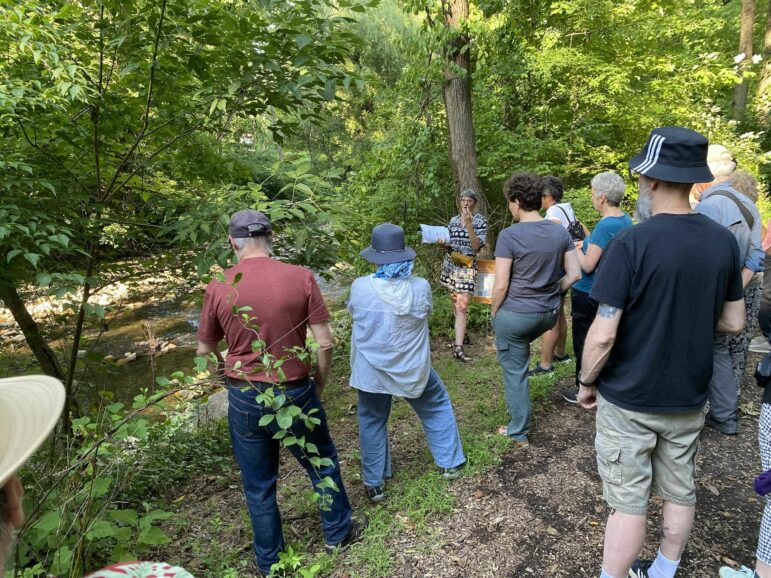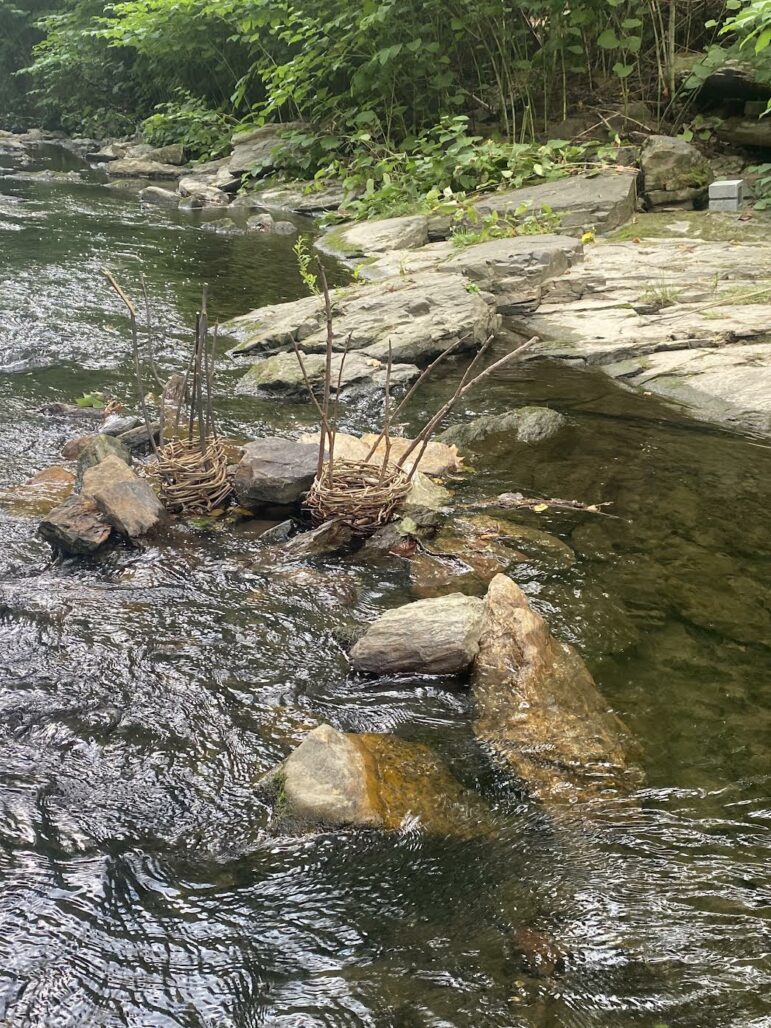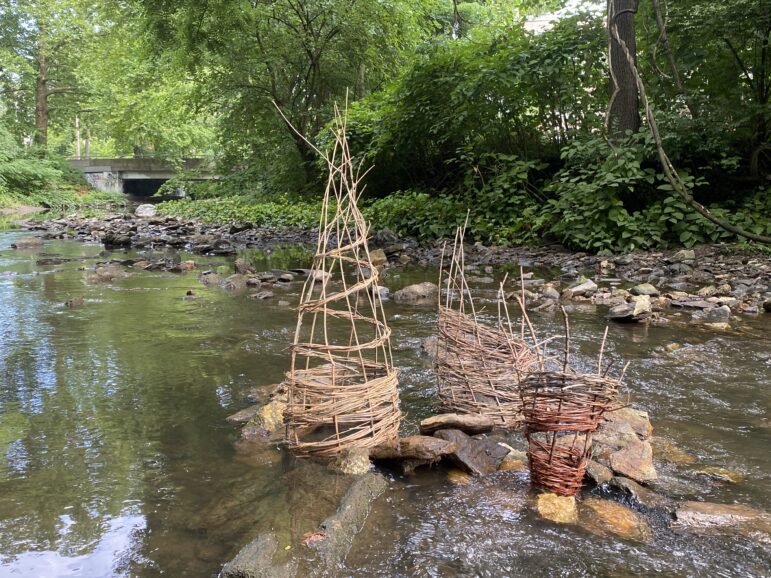Against the backdrop of biodiversity loss and climate change, today, more than ever, it’s vital that people have opportunities to experience and develop relationships with local ecosystems and species. A World in our Streams is a site-specific sculptural project by artist Rebecca Schultz, designed to make important connections between people and place, relationships which are especially needed by many people at this moment.
Rebecca Schultz’ sculptures are inspired by the forms and materials utilized by Indigenous peoples to build traditional fish traps, along with Hester-Dandy substrate samplers, a tool used to collect macroinvertebrate samples from freshwater. Schultz’ compelling take on these forms are exhibited in Tookany Creek, in High School Park, Elkins Park, PA. A World in Our Streams combines creative artworks and conservation science to explore the dynamic habitat of aquatic macroinvertebrates.
Jeanne Dodds, Endangered Species Coalition Creative Engagement Director, shares a conversation with Rebecca Schultz about her creative project A World in our Stream, and how this project fits into her larger creative practice supporting biodiversity conservation.
Jeanne Dodds: What are aquatic macroinvertebrates, anyhow? What makes them such fascinating and ecologically significant species? And amazingly, some macroinvertebrates are pollinators…. tell us how that works!
Rebecca Schultz: Macroinvertebrates are animals without a backbone that you can see without using a microscope or magnifying glass. This includes insect larvae–such as dragonflies, damselflies, stoneflies, and mayflies–who spend more of their lives in the water than they do on land. Many flies live only weeks, days, or even minutes after they emerge from the water as adults–they don’t have mouth parts to eat–and they focus primarily on reproducing before they die. Freshwater snails, worms, and crustaceans like crayfish and their smaller cousin called scuds are also macroinvertebrates.
One of the important things about macroinvertebrates is that they are excellent bioindicators. They help us to assess the health of a water body, because they live most of their life in the stream and different ones are more or less sensitive to pollution. So if you find certain species–for example, caddisflies, which I found in the stretch of Tookany Creek where I installed my sculpture–that are very sensitive to pollution. So their presence indicates that the creek is healthy. The other thing about macroinvertebrates is that some–like the stonefly–are pollinators, or they are food for other pollinators, such as hummingbirds. In short, they’re a critically important part of watershed ecosystems.
JD: Why do you think it’s important to recognize and pay attention to less well known species, such as macroinvertebrates?
RS: I consider myself pretty knowledgeable about the natural world and local ecosystems, but I didn’t know anything about macroinvertebrates until I took the training on them. This lack of knowledge was reflected in the audience for my artist talk–so many people came up to me afterwards and thanked me for raising awareness about these creatures that most of them have never thought about.
I think this awareness is particularly important because insects are a critical component of our ecosystems. They make up over two-thirds of the world’s 1.5 million known animal species, and current estimates indicate that 40% of insect species are in decline, and a third are endangered. Habitat loss, the use of pesticides and climate change are the most significant threats. So learning about macroinvertebrates is the first step to being motivated to protect their habitat.

Photo caption: Rebecca Schultz delivering her Artist Walk and Talk to attendees at High School Park, for the opening of the A World in Our Streams installation
JD: How did you make the connection between your creative practice and themes of macroinvertebrate habitat in your current project, A World in Our Streams?
RS: For a number of years, the impetus for my creative work has been to help repair the relationship between us humans and the more-than-human world by reconnecting us with the ecosystems that surround us. I believe that doing so is critical to our collective survival in the face of the climate and biodiversity crises.
Watersheds have evolved as the ecosystems I’m particularly interested in–they are the essence of what scientists are increasingly calling the critical zone, where rock, water, plants, fungi, and–based on newer science, microbes–interact with each other to create the foundation for life. And, where I live, our environmental challenges center on water–how to adapt to heavier rainfall and stormwater runoff, combined sewer overflow, and flooding due to heavier rainfall. It’s important to me to have some baseline scientific knowledge of the ecosystems I work with, so in 2022 I became a streamkeeper with the Tookany/Tacony-Frankford Watershed Partnership (TTF). I monitor a section of Tookany Creek once a month, and through that work have attended trainings to better understand how to assess the health of watersheds. I was offered the opportunity to get certified as a Save Our Streams monitor, which entailed learning how to sample and identify macroinvertebrates. And I became really fascinated with them!
JD: How did you develop the relationship between your artwork and the location of High School Park and Tookany Creek? Why and how is this place specifically important to your work?
RS: I moved to this area in 2016, after 20 years of living in the San Francisco Bay Area, where the regional parks were one of my favorite places to spend time. High School Park is a 10-minute walk from my home, and while it’s small, it’s mighty! For thirty years, our neighbors have worked diligently to restore diverse native ecosystems, from a meadow to woodlands, to the stretch of Tookany Creek that runs through the Park. It’s such a special place.
In the last 8 years, I have learned so much about native ecosystems–much of that from the relationships I’ve built with local environmental organizations, like Friends of High School Park and the Tookany/Tacony-Frankford Watershed Partnership (TTF). Tookany Creek winds through Cheltenham Township on its way to the Delaware River; through my volunteering as a streamkeeper and the continued evolution of my practice, I’ve become more and more connected to this landscape. So much so, that when my stepson passed away in January, our family planted a tree for him in High School Park. We all visit the tree–an American Persimmon–regularly. It has become a site of solace for us, in the face of profound grief.
JD: Please tell us a bit more about your artistic practice, specifically, your previous projects at High School Park involving watersheds and soils.
RS: About ten years ago, I re-focused my creative practice on visual art, after decades of making theater and performance art. At the same time, I was becoming more aware of the scale of the intertwined climate and biodiversity crises, and wanted my work to be a response. As I became more interested in art and ecology, I wanted to start making outdoor installations with natural materials. In 2020, during covid, I asked Cynthia Blackwood, the park manager, if I could do some installations in High School Park. I was very grateful to have the opportunity to experiment in this way. The following year, my friend and fellow artist Julia Way, who was on the Friends of High School Park board, started a summer outdoor art program. I collaborated with Brenda Howell on the piece Walk the Green Path, which created a pathway through the native meadow, with signage about the common, latin, and Lenape names of medicinal plants that were growing there. In 2023, my community-engaged, participatory art and community science project Mapping Our Watershed was also part of the summer series.
Also in 2023, Cynthia was in the process of creating a “stumpery” in the Park, and asked me if I would make a stump sculpture with pieces of trees that had been cut down. Tree stumps and fallen trees are the site of rich ecosystems, including plants, mosses, lichen, fungi, and insects. Once I had finished the piece, Cynthia put native plants in around it. I visit the stump sculpture every single time I’m at the park, because it is constantly changing and evolving. It is now a collaboration with thousands of other living things, what I call my more-than-human relations. This piece inspired me to want to create more sculptural habitat, and led me to A World in Our Streams.
JD: What do you hope that audiences and participants engaged with this project take away from their experiences with the installation and macroinvertebrates?
RS: I hope they gain a greater understanding of, and appreciation for, aquatic macroinvertebrates, so that they are more motivated to conserve and protect them as an essential part of our watersheds. In Cheltenham Township, water is one of our most pressing environmental issues–how we will adapt to increasing heavy rainfall and the resulting stormwater runoff, and how we will protect the biodiversity that keeps our watersheds healthy so that they are more resilient. My work is grounded by an intent so beautifully captured by Senegalese environmentalist Baba Dioum: “In the end we will conserve only what we love; we will love only what we understand; and we will understand only what we are taught.”
I also want audiences to understand that art is an important vehicle for imagining and constructing the world we want, a world where we acknowledge and step into our role as a part of ecosystems, not separate from it. I was in France recently, and had the incredible experience of seeing cave paintings that were made 27,000 years ago. Our ancestors had short and hard lives, but they still made art. It’s essential to our humanity.
JD: Is there anything else about the project you’d like to share with the ESC audience?
RS: This project has been a lesson in resilience and flexibility. I installed three sculptures woven from willow branches, inspired by the forms of indigenous fish traps, in Tookany Creek the day before my artist talk. I also put two sculptures inspired by Hester Dendy macroinvertebrate samplers into the stream, tied to cinder blocks. That night, there was a storm where we had nearly an inch of rain in an hour and 35 mph wind gusts. I came back the next morning, and the woven sculptures were almost completely destroyed. One of the Hester Dendys was nowhere to be found. Water is extremely powerful. I quickly rebuilt two woven forms, that are shorter and more densely woven than the first set, and installed them in the creek. It’s now been more than two weeks, and they’re doing okay. They’re actually collecting leaves and other natural debris, which is a good thing. They’re evolving in collaboration with the creek. On August 24th, I will co-facilitate a workshop with my friend and collaborator Ryan Neuman from TTF, where we will sample macroinvertebrates from the sculptures and see what we find!
A World in Our Streams exhibit is sponsored by the Endangered Species Coalition Pollinator Protectors campaign, in collaboration with Friends of High School Park.
Photo credits: @jwayprojects and @djibrinemainassara




0 comments on “Interview with sculptor, Rebecca Schultz”